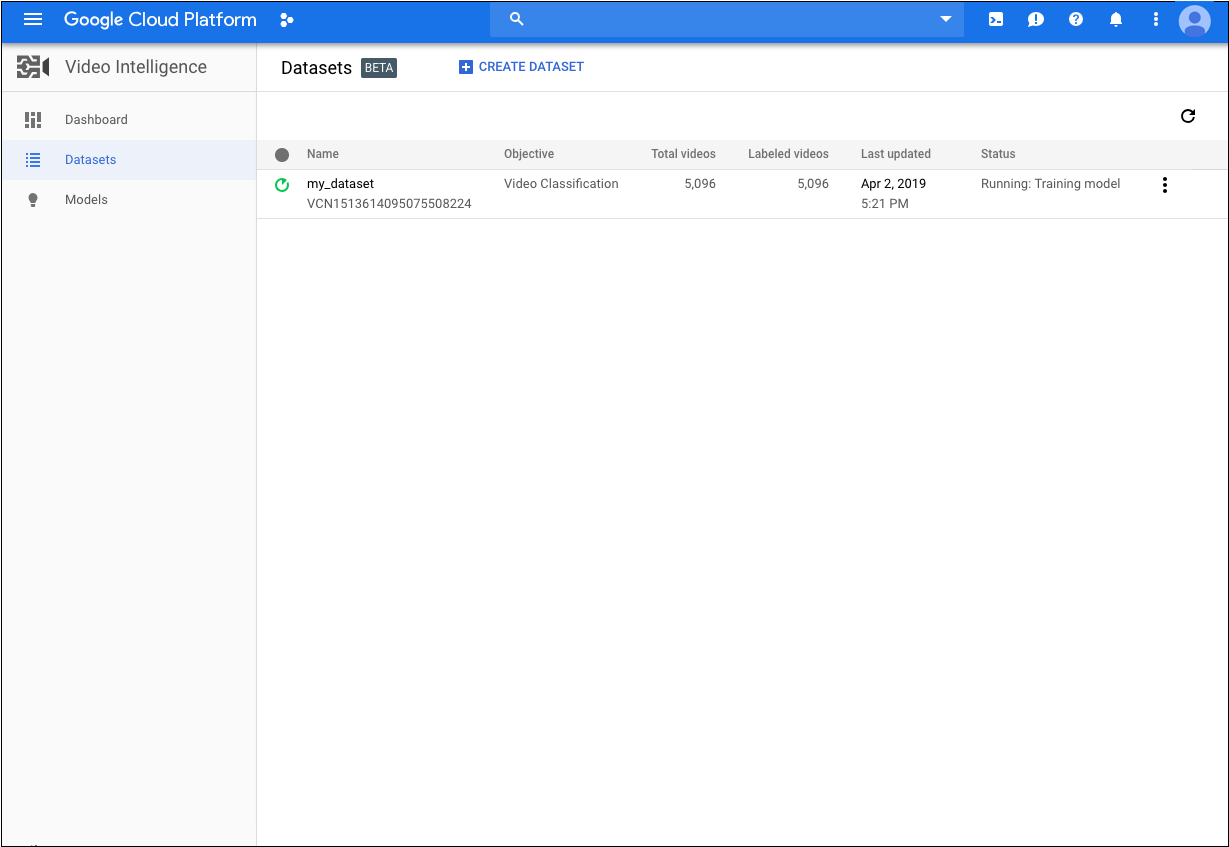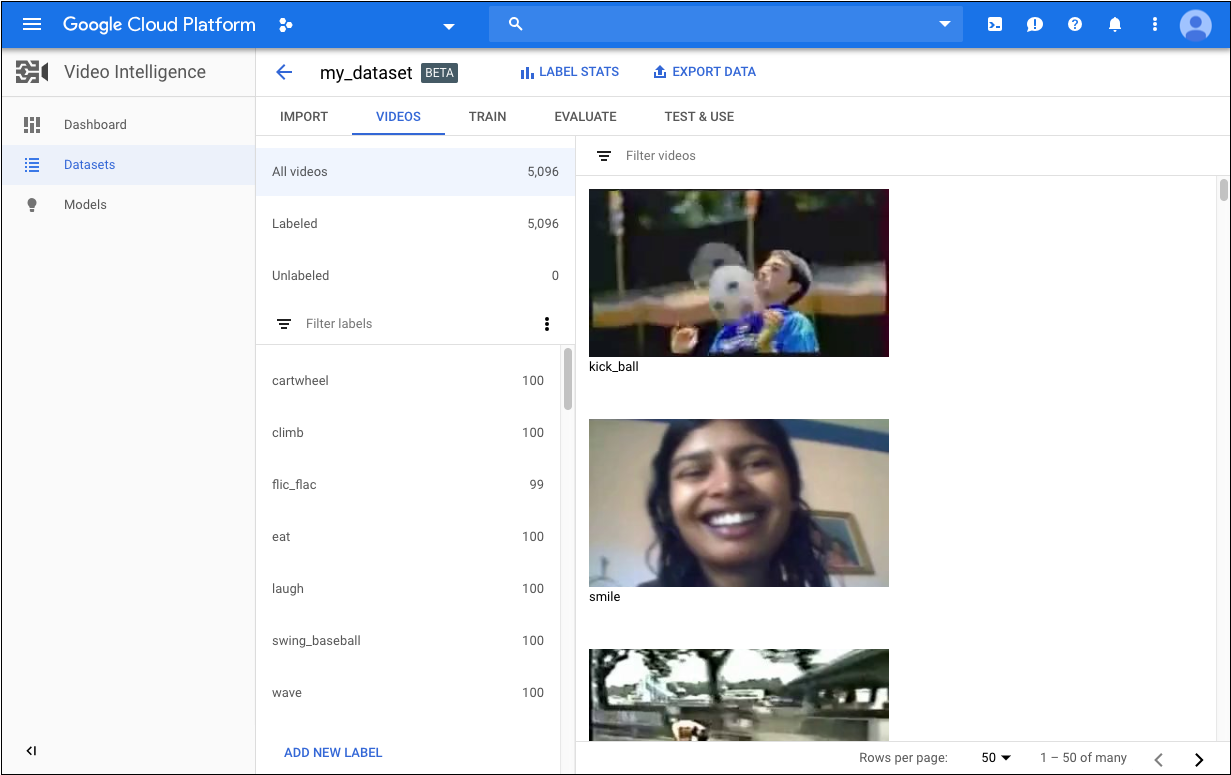管理模型
使用您提供的准备好的数据集训练模型。AutoML Video Intelligence 分类使用您数据集中的训练项来训练、测试和评估模型的性能。evaluate接着,您可以查看结果、根据需要调整训练数据集,并使用改进的数据集训练新模型。
训练模型可能需要几个小时才能完成。借助 AutoML API,您可以检查训练的状态。
您每次开始训练时,AutoML Video Intelligence 分类都会创建新模型,因此您的项目可能包含很多模型。您可以获取项目中模型的列表,也可以删除不再需要的模型。
模型的最长使用期限为两年。该时间期限过后,您必须创建并训练新模型,才能继续对内容进行分类。
使用 curl 或 PowerShell
为了更方便地在本主题中运行 curl(或 PowerShell)示例,请设置以下环境变量。将 project-id 替换为您的 Google Cloud 项目的名称。
export PROJECT_ID="project-id"
训练模型
如果您拥有一个包含一组固定训练项的数据集,您就可以创建并训练模型了。
网页界面
-
打开 AutoML Video 界面,导航到数据集页面。

-
选择要用于训练模型的数据集。
所选数据集的显示名会显示在标题栏中,该页面还会列出数据集中的各个训练项及其标签。

-
查看完数据集后,点击标题栏正下方的训练标签页。
训练页面会提供对数据集的基本分析,并就其是否适合训练为您提供相关建议。如果 AutoML Video 建议更改,请考虑返回视频页面,添加内容或标签。
- 准备好数据集后,请点击开始训练以创建新模型,如果要创建其他模型,则可以点击训练新模型。
REST
在使用任何请求数据之前,请先进行以下替换:
- dataset-id:此 ID 是数据集名称的最后一个元素。例如,如果数据集的名称为
projects/434039606874/locations/us-central1/datasets/VCN3104518874390609379,则数据集 ID 为VCN3104518874390609379。 - 注意:
- project-number:您的项目编号
- location-id:在其中添加注解的 Cloud 区域。支持的云区域为:
us-east1、us-west1、europe-west1、asia-east1。如果未指定区域,系统将根据视频文件位置确定区域。
HTTP 方法和网址:
POST https://automl.googleapis.com/v1beta1/projects/project-number/locations/location-id/models
请求 JSON 正文:
{
"displayName": "test_model",
"dataset_id": "dataset-id",
"videoClassificationModelMetadata": {}
}
如需发送请求,请选择以下方式之一:
curl
将请求正文保存在名为 request.json 的文件中,然后执行以下命令:
curl -X POST \
-H "Authorization: Bearer $(gcloud auth print-access-token)" \
-H "x-goog-user-project: project-number" \
-H "Content-Type: application/json; charset=utf-8" \
-d @request.json \
"https://automl.googleapis.com/v1beta1/projects/project-number/locations/location-id/models"
PowerShell
将请求正文保存在名为 request.json 的文件中,然后执行以下命令:
$cred = gcloud auth print-access-token
$headers = @{ "Authorization" = "Bearer $cred"; "x-goog-user-project" = "project-number" }
Invoke-WebRequest `
-Method POST `
-Headers $headers `
-ContentType: "application/json; charset=utf-8" `
-InFile request.json `
-Uri "https://automl.googleapis.com/v1beta1/projects/project-number/locations/location-id/models" | Select-Object -Expand Content
{
"name": "projects/project-number/locations/location-id/operations/operation-id",
"metadata": {
"@type": "type.googleapis.com/google.cloud.automl.v1beta1.OperationMetadata",
"progressPercentage": 100,
"createTime": "2020-02-27T01:56:28.395640Z",
"updateTime": "2020-02-27T02:04:12.336070Z"
},
"done": true,
"response": {
"@type": "type.googleapis.com/google.cloud.automl.v1beta1.Model",
"name": "projects/project-number/locations/location-id/models/operation-id",
"createTime": "2020-02-27T02:00:22.329970Z",
"videoClassificationModelMetadata": {
"trainBudget": "1",
"trainCost": "1",
"stopReason": "BUDGET_REACHED"
},
"displayName": "a_98487760535e48319dd204e6394670"
}
}
Java
如需向 AutoML Video 进行身份验证,请设置应用默认凭据。如需了解详情,请参阅为本地开发环境设置身份验证。
Node.js
如需向 AutoML Video 进行身份验证,请设置应用默认凭据。如需了解详情,请参阅为本地开发环境设置身份验证。
Python
如需向 AutoML Video 进行身份验证,请设置应用默认凭据。如需了解详情,请参阅为本地开发环境设置身份验证。
获取模型的相关信息
训练完成后,您可以获取有关新创建的模型的信息。
本部分中的示例返回模型的基本元数据。要获取有关模型准确率和就绪情况的详细信息,请参阅评估模型。
网页界面
-
前往 AutoML Video 界面中的模型页面。

- 点击要查看的模型的名称。
REST
在使用任何请求数据之前,请先进行以下替换:
- model-name:创建模型时的响应提供的模型全名。全名的格式如下:projects/project-number/locations/location-id/models/model-id
- dataset-id:替换为数据集的数据集标识符(而不是显示名)。例如
VCN3940649673949184000 - project-number:您项目的编号
HTTP 方法和网址:
GET https://automl.googleapis.com/v1beta1/model-name/modelEvaluations
请求 JSON 正文:
{
"displayName": "test_model",
"dataset_id": "dataset-id",
"videoClassificationModelMetadata": {}
}
如需发送您的请求,请展开以下选项之一:
您应该收到类似以下内容的 JSON 响应:
Java
如需向 AutoML Video 进行身份验证,请设置应用默认凭据。如需了解详情,请参阅为本地开发环境设置身份验证。
Node.js
如需向 AutoML Video 进行身份验证,请设置应用默认凭据。如需了解详情,请参阅为本地开发环境设置身份验证。
Python
如需向 AutoML Video 进行身份验证,请设置应用默认凭据。如需了解详情,请参阅为本地开发环境设置身份验证。
列出模型
一个项目可以包含许多模型。本部分介绍如何检索项目的可用模型列表。
网页界面
前往 AutoML Video 界面中的模型页面,查看项目中的模型。
如需查看其他项目的模型,请从标题栏右上角的下拉列表中选择该项目。
REST
在使用任何请求数据之前,请先进行以下替换:
- model-name:创建模型时的响应提供的模型全名。全名的格式如下:projects/project-number/locations/location-id/models
- 注意:
- project-number:您的项目编号
- location-id:在其中添加注解的 Cloud 区域。支持的云区域为:
us-east1、us-west1、europe-west1、asia-east1。如果未指定区域,系统将根据视频文件位置确定区域。
HTTP 方法和网址:
GET https://automl.googleapis.com/v1beta1/projects/project-number/locations/location-id/models
如需发送您的请求,请展开以下选项之一:
您应该收到类似以下内容的 JSON 响应:
Java
如需向 AutoML Video 进行身份验证,请设置应用默认凭据。如需了解详情,请参阅为本地开发环境设置身份验证。
Node.js
如需向 AutoML Video 进行身份验证,请设置应用默认凭据。如需了解详情,请参阅为本地开发环境设置身份验证。
Python
如需向 AutoML Video 进行身份验证,请设置应用默认凭据。如需了解详情,请参阅为本地开发环境设置身份验证。
删除模型
以下示例演示了如何删除模型。
网页界面
- 在 AutoML Video 界面中,导航到模型页面。

- 点击要删除的行最右侧的三点状菜单,然后选择删除。
- 在确认对话框中点击确认。
REST
在使用任何请求数据之前,请先进行以下替换:
- model-id:将替换为模型的标识符
- 注意:
- project-number:您的项目编号
- location-id:在其中添加注解的 Cloud 区域。支持的云区域为:
us-east1、us-west1、europe-west1、asia-east1。如果未指定区域,系统将根据视频文件位置确定区域。
HTTP 方法和网址:
DELETE https://automl.googleapis.com/v1beta1/projects/project-number/locations/test/models/model-id
如需发送您的请求,请展开以下选项之一:
您应该收到类似以下内容的 JSON 响应:
Java
如需向 AutoML Video 进行身份验证,请设置应用默认凭据。如需了解详情,请参阅为本地开发环境设置身份验证。
Node.js
如需向 AutoML Video 进行身份验证,请设置应用默认凭据。如需了解详情,请参阅为本地开发环境设置身份验证。
Python
如需向 AutoML Video 进行身份验证,请设置应用默认凭据。如需了解详情,请参阅为本地开发环境设置身份验证。
